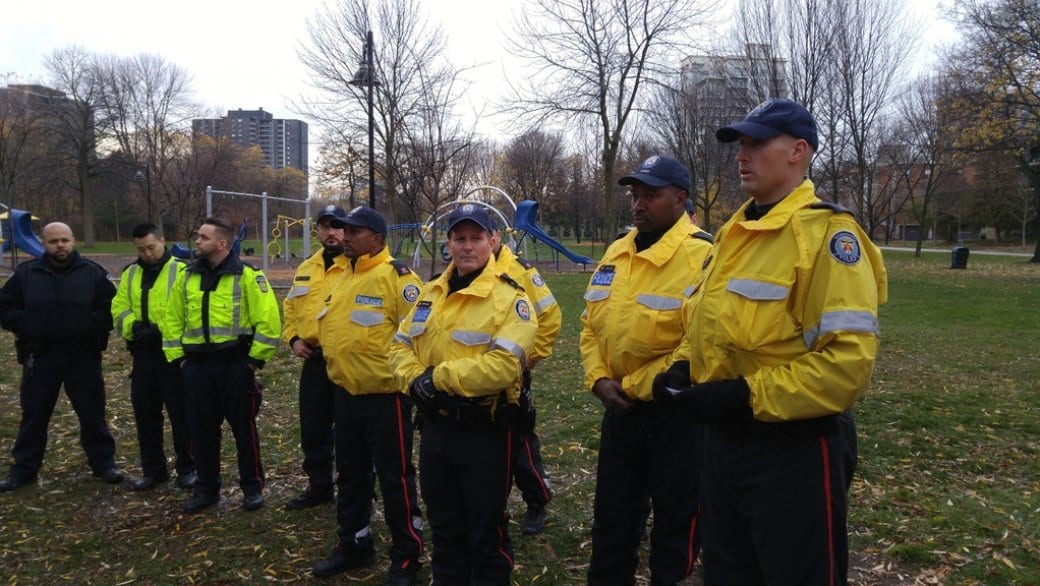On Nov 19, 2016, I was one of the protesters in Marie Curtis Park condemning Project Marie at the Walk the Beat event. The event, put on by Toronto Police Service, was an attempt to “take back the park.”
I’m livid about Project Marie, especially considering this recent sting exists in a long lineage of Toronto police actions that target queer sexuality when it takes up public space — which is by default, always heterosexual space. We can’t afford to pretend Project Marie isn’t deeply insulting to queers and to women. Let’s look at how much Toronto police defend and serve straight male comfort and ignore the realities and needs of others.
Access to queer spaces, safety and the shooting at Pulse nightclub
A lot of people I’ve spoken to across the sexual orientation spectrum don’t understand why queer cruising needs to happen in an open, multi-function, multiple-community-serving space like Marie Curtis Park. Have sex in your home, they say. Use an app to meet people. Come downtown to Church Street and dance in a club.
This line of thought ignores cultural and class barriers that many people in our community face. Though many of us have phones and data and can use HER and Grindr fearlessly, there are an equal number of us queers who don’t have that safety or privilege. Public queer cruising spaces fulfill a vital social function because they serve queers who might otherwise be completely excluded from being able to explore and express their sexuality.
This includes queers who are closeted; queers who can’t make their way downtown to more socially-acceptable queer hubs; queers who don’t fit into what can be a very narrow view of what is considered attractive in queer culture; queers who are not fluent in English; queers who cannot identify as queer because of cultural background and/or internalized homophobia; queers who can’t afford phones or computers to meet people online; queers who can’t afford a private space in which they can explore their sexuality; and queers who feel safer exploring their sexuality in an open or public space.
This last point applies to me. I’m a five-foot-tall, hundred-pound person. If I enter a private space with another person — my home, their home — I have to be deeply confident that they aren’t going to try rape, beat or murder me, because if I’m wrong, physically there’s not much I’m going to be able to do to stop them.
For that reason, I have a lot of sexual encounters, especially early on in building a relationship, in spaces that are not private residences. I’m a regular at the sex parties Sapphic Aquatica and Bed, Bathhouse and Beyond at Oasis Aqualounge (Sapphic Aquatica is exactly the kind of event that led to the Pussy Palace raid in Club Toronto back in 2000. Oasis Aqualounge is now in the space where the former club was located). I’ve had sex in the bathrooms of LGBT bars and on club dancefloors. These have been ways and circumstances in which I felt I could explore my sexuality without putting my safety or my property at risk.
And then this summer’s shooting at Pulse nightclub happened, and while that shook all of us in different ways, it made me question the definition of and safety of queer space.
When I first came out, going to an LGBT dance club felt like there was finally a place I could be myself safely. I work at Glad Day Bookshop on Church Street. I’ve performed at Buddies in Bad Times Theatre quite a bit. The shooting at Pulse nightclub made me think about the fact that by inhabiting known, recognizable and enclosed queer establishments, from a certain perspective, I was making it very easy for a bigot with a gun to know where to find me.
So if queer establishments aren’t necessarily safe, and neither are private spaces, then places like the paths and bushes of a large and secluded park in Etobicoke are exactly where we queers need to be. Rather than punish us for expressing our sexuality the way we do, I wish those whose batons our tax dollars pay for would engage with us about what support the queer community needs.
This lack of engagement, however, about the unmet needs of the queer community surrounding space and safety, actually points to what Toronto police think of the men they spent weeks targeting through undercover police work. Toronto police see the cruisers of Marie Curtis Park as perverts. I see us as people living in frightening and isolating times.
Straight male complaints, sexual harassment and dismissing women’s everyday public safety realities
When I was protesting Project Marie, I had a lot of enlightening conversations about what was at play in the weeks of undercover police work that went into writing mostly bylaw-infraction tickets. I chatted with one of the local residents, a straight white man who was there celebrating the police action. This man told me that he is the father of toddler twin girls.
This straight father claimed that while walking through the park, a man he didn’t know touched his arm. He mentioned being verbally propositioned by a man. I told this father that while I understood his alarm at unwanted sexual contact, that being touched, being verbally propositioned — as a person with breasts and a vagina, that is my daily reality. I asked this straight father if he thought that the police were using a disproportionate amount of force to protect local straight men from the kind of harassment women are subjected to regularly.
He responded yes, it is disproportionate, but unfortunately the sexual harassment and assault of women happens everywhere, so there’s nothing that can be done about it.
He continued by telling me that men keep getting hit on by men in this park — unlike the way women are treated, this was a specific and small enough issue to tackle, and it was happening near his home, so he was glad the police did something about it.
Overblown reactions and misuse of police discretion
Constable Kevin Ward, who has been the public face for this police sting, told a story to a group of us protesters about the kind of lewd sexual conduct that was allegedly directed at him while undercover in Marie Curtis Park. He claimed that a man in the park had walked up to him, touched the inside of his arm, and asked him, “What are you looking for?”
I thought adults talking to other adults about sex before hooking up was supposed to happen.
Ward then says he pulled down the zipper of his coat to show the man hitting on him his badge (as if asking what a person is looking for is a crime), and the man reached into Ward’s coat and touched Ward’s chest. This was shockingly sexual behaviour and against park bylaws, according to Ward.
I pressed this subject and asked Ward if I would be charged if I asked to kiss him, or if I asked to touch his hand. He said no.
I asked him if I would be charged if I asked to touch his penis. He said I may be ticketed, because according to him that would be me engaging in sexual behaviour in a park.
There’s a lot we still don’t know about Project Marie, and we still have no verified answer on the specific charges laid. What I know for sure is that Ward told me I could be charged for asking another adult if they’d like to have a sexual interaction with me.
At police discretion, an officer like Ward can decide that an adult asking another adult if they’d like to hook up is lewd conduct. He can decide to charge a man for asking what are you looking for, but not charge a woman asking to kiss him. If Ward decides that your behaviour is unacceptable and offensive, he’ll find a way to charge you for it.
I asked Ward when was the last time Toronto police did weeks of undercover police work investigating complaints from women about sexual harassment in public spaces. He said he didn’t know. I asked Ward if he would ticket someone for calling me a slut, in this park. He said no, because me being called a slut was not sexual harassment.
Not only does Project Marie demonstrate how little awareness Toronto police care to have about the way queer people are marginalized, but it insults those of us regularly on the receiving end of sexual harassment and violence. Police have the resources to defend communities — but those resources seem to be powerfully evoked when there’s a perceived threat to straight masculinity.
It was difficult to stand in Marie Curtis Park, watching the police hand out hot chocolate and encourage children to play in the police cruiser they’d driven up on the grass. I’d like to be one of the toddler twin girls I saw, having an out-of-the-ordinary day of fun in the park with big police officers I can admire. It would be less exhausting for me to believe that Project Marie was fair. But I know too well that what the toddler twin girls need of Toronto police is the same thing people of colour need, that women need and the same thing us queers need: a police force that tackles the intimidation, harassment and crime in our city that is so entrenched that straight men think it’s normal.


 Why you can trust Xtra
Why you can trust Xtra


